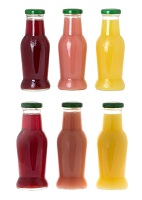Antioxidant berry drink:
how to choose the best one

An antioxidant berry drink is a drink that contains a specified berry or mix of berries and fruit. Most berries are naturally high in antioxidants, so when they are concentrated into a drink they make a good antioxidant berry drink.
As a rule, the higher the percentage of berries the higher the antioxidants in the drink. The amount of antioxidants, measured in Oxygen Radical Absorbency Capacity (ORAC), depends on the berries being used and their concentration. For this reason not all drinks that claim to be an antioxidant berry drink are the same in ORAC, or in other words - they do not contain the same amount of antioxidants.
Part of the problem in determining the true immune health value of a juice is that there are over 4,000 plant based antioxidants. With so many of them it is not difficult for a drink to claim it is an antioxidant drink, no matter what the concentration is.
When we look at antioxidant drinks what we really need to know is the ORAC value contained in one ounce or in the recommended serving size. But currently FDA does not require commercial beverages that claim to be an antioxidant drink to list the number of ORAC or the dry weight of the fruit in the drink or any other relevant information that would give us the ability to rate the drink by its nutritional content.
What can we do? The answer - we have to read the labels. Labels will help you determine if the antioxidant berry drink is worth your money.
It is important to differentiate between the types of antioxidant berry drinks.
MAIN CATEGORIES OF JUICES ON THE MARKET
- Fruit punches or cocktails, juice/fruit drinks – only few typical fruits used, many other ingredients added (artificial color and flavor added, high fructose corn syrup or sugar added, sometimes added vitamins, preservatives, main fruit/berry is at the end of ingredient list meaning its percentage is low). Availability: at all grocery stores.
- 100% juices from concentrates reconstituted in water – only typical fruits used like apple, grape, pear, orange, kiwi, mango, cranberry, blueberry, pomegranate (vitamins and calcium often added, usually no added sugar or preservatives, main fruit/berry may be at the end of ingredient list - for example, blueberry juice would have apple and pear juice as main ingredients acting as fillers and diminishing the nutritional benefit from blueberries as there is no way to determine blueberry concentration). Beware of 100% reconstituted juices in light, diet or sugar free versions – they most likely have artificial sweeteners added, such as aspartame, sucralose or saccharine, and may contain preservatives. Aspartame has been scientifically proven to deplete
Glutathione
levels in the brain in a rat model, and also is the source of methanol toxicity. Availability: at all grocery stores.
- Berry/fruit juice concentrates – pure juice concentrates, no other ingredients but the main listed fruit/berry (no added sugar, no added color, no added vitamins, no preservatives, very thick consistency, some typical fruits used but primarily specialty berry/fruit used - tart cherry, blueberry, cranberry, aronia (chokeberry), elderberry, pomegranate, acai, goji (wolfberry), mangosteen, noni, maqui, camu camu. They are available both as mixed berry concentrates and single berry concentrates. These juice concentrates can be consumed straight – one serving is usually 1 oz., or mixed with 6-8 oz. of water, or added to homemade smoothies, plain yogurt, oatmeal etc. Availability: only at health food stores, some organic food stores, online and through network distributors.
WHAT TO AVOID
- stay away from berry/fruit drinks listed in #1 above as they have almost zero nutritional value.
- stay away from light, diet and sugar free versions of 100% juices in #2 above.
WHAT TO CHOOSE
- drinks that are 100% juice without any additives and no added sugar.
- berry/fruit juice concentrates.
And out of these two,
juice concentrates provide the highest possible ORAC values and the highest possible nutrient content of the fruit/berry that was used.The next thing to look for in an antioxidant drink is whether it has more than just one plant source. Is it just acai, or just orange, or just cranberry? Typically, a mix of juices gives a broader spectrum of antioxidants and thus is a better boost to your immune system. But, as in the case of
tart cherries
or blueberries, one plant source is desired – tart cherries for anthocyanins and
melatonin
(neurological help, glutathione booster, sleep aid) and blueberries for carotenoids (eye health).
The one thing to keep in mind though is that 100% juices and juice concentrates are still high in natural sugars. Consuming too much sugar, even natural sugar, can become a problem. So it is important to note the amount of sugar in your juice drinks and regulate sugar consumption from other food sources throughout the day accordingly.
HOW TO MAKE YOUR OWN ANTIOXIDANT BERRY DRINK
An alternative to commercial 100% juice drinks is to make them yourself from juice concentrates such as tart cherry, blueberry, aronia (chokeberry), acai berry, goji (wolfberries), mangosteen, noni, pomegranate, cranberry.
Mix them with water, either individually or several together, in concentrations that suit your taste. This way you can include into your diet a wide variety of antioxidants in highest concentrations and reduce the amount of added sugar, artificial additives and fillers.
Return to Top of Antioxidant Berry Drink
Return to Antioxidant Juice Comparison
Return to Tart Cherries
Return to Melatonin
Return to Home
